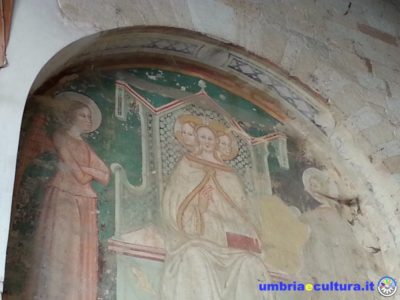San Pietro is one of the richest and most majestic churches in Perugia, a collection of art so considerable as to be second in the city only to the National Gallery of Umbria, and such as to make it impossible, here, a meticulous description.
Let’s focus the attention on some of the works that the church contains, witnesses of the long life of this site of art and devotion, where legend mixes to the story, making the atmosphere, if possible, even more engaging.
The architecture with three naves stuns for the richness of canvases, paintings, frescoes, (about 150 works), perceptible only after a first sense of disorientation.
The first “surprise”, the most intriguing, and noteworthy, is a fresco on the outside, on the right side of the entrance door, where the image of a woman with three heads seated on the throne stands out: it is a rare iconography of God as a woman, an image that refers to the deep meaning of God understood as mother, linked to creation. This image, by Giotto’s school, very rare, for a long time was hidden from view being considered blasphemous; it is always for this reason that there is no documentation on her, an aspect that feeds curiosity and mystery.
The primates of San Pietro, to build which, in the tenth century, recycled materials from a nearby temple dedicated to Jupiter were also used, are not finished: on the internal wall, above the entrance door, there is the largest canvas of Europe (74 sq mt): the subject is the triumph of the Benedictine order, with Saint Benedict in the center, the Benedictines living under the Sun and the Moon, and the passed ones over the clouds. The canvas, like the other 10 positioned above the arches of the aisles, can be read in two ways: looking carefully, the sun and the moon form the pupils of a dragon, which symbolizes sin, which threatens the living Benedictines but which cannot harm those already blessed.
In the left aisle, a wooden crucifix with a perfect anatomy also contains two small secrets: depending on the point of view from which it is observed, the face of Jesus assumes two different attitudes, on the one hand a “sentient” attitude, that is thirsty, with half-closed eyes and slightly open mouth, on the other side abandoned to death, with eyes and mouth closed. The second little secret is a mechanism found inside the crucifix during a restoration, which allowed, at the passage of the procession, to let out the tongue of Jesus eager to drink.
A column of the left nave, curiously decentralized with respect to its base, is the “protagonist” of the so-called “column miracle”. During the construction of the church, and precisely during the erection of this monolithic column, a maneuver error caused the fall of the same, stopped with a cross sign by Pietro Vincioli, the founder of the church, before it could kill the workers who they were below her.
Recently another treasure has been added to the many inside the basilica of San Pietro: an early Christian temple, from the first century a.C., was found under the floor of the church. This ancient presence, of the same age as the apostles, testifies that this site has always been considered sacred and was dedicated to prayer. It is possible, and not entirely imaginative, that St. Peter, during his visits to the various communities around Rome, may have passed through here too.
Benedetta Tintillini
Find the San Pietro church on Google Maps:




